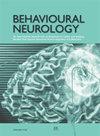丙戊酸钠和利培酮对MK-801诱导小鼠急性过度运动的神经行为差异
IF 2.7
4区 医学
Q2 CLINICAL NEUROLOGY
引用次数: 1
摘要
目的谷氨酸系统在成瘾、癫痫、痴呆和精神病等神经精神疾病的发生发展中起重要作用。MK-801(二唑西平)是一种非竞争性n -甲基- d -天冬氨酸(NMDA)受体拮抗剂,可以增加小鼠模型的运动活性和模仿精神分裂症样特征的刻板神经行为。本研究将探讨利培酮和丙戊酸对mk -801诱导的神经行为改变的神经药理学差异。方法选用国家实验动物中心提供的C57BL/6J雄性小鼠。通过视频跟踪系统和步态测试,利用开阔场地评估药物效果。居住后,注射利培酮(0、0.1 mg/kg)或丙戊酸(0、200 mg/kg),运动30min。随后,小鼠腹腔注射MK-801 (0,0.2 mg/kg),并进行运动60 min。在服用研究药物后,研究人员测量了步态行为,如步角、步幅和站姿宽度。结果利培酮和丙戊酸对大鼠的运动活动无明显影响。注入MK-801后,整个裸地的移动距离和速度都大大增加。与盐水注射组相比,0.1 mg/kg利培酮能完全抑制mk -801诱导的大鼠过度运动(p < 0.001)。丙戊酸(200 mg/kg)可部分抑制MK801诱导的大鼠过度运动。结论与丙戊酸相比,利培酮对MK-801诱导的过度运动的疗效更明显。丙戊酸的部分抑制可能暗示了通过调节谷氨酸能神经传递来辅助治疗精神病患者的精神药理学证据。本文章由计算机程序翻译,如有差异,请以英文原文为准。
Neurobehavioral Differences of Valproate and Risperidone on MK-801 Inducing Acute Hyperlocomotion in Mice
Objective
The glutamate system plays a major role in the development of neuropsychiatric disorders such as addiction, epilepsy, dementia, and psychosis. MK-801 (dizocilpine), an uncompetitive N-methyl-D-aspartate (NMDA) receptor antagonist, could increase locomotor activity and stereotyped neurobehaviors mimicking schizophrenic-like features in the mouse model. The study would explore the neuropharmacological differences of risperidone and valproic acid on the MK-801-induced neurobehavioral changes.
Methods
The subjects were male C57BL/6J mice obtained from the National Laboratory Animal Center. Drug effects were assessed using the open field with a video-tracking system and gaiting tests. After habitation, risperidone (0, 0.1 mg/kg) or valproic acid (0, 200 mg/kg) was injected and ran locomotion for 30 mins. Sequentially, mice were followed by intraperitoneal injection (i.p.) with MK-801 (0, 0.2 mg/kg) and ran locomotion for 60 mins. Gaiting behaviors such as step angles, stride lengths, and stance widths were measured following the study drugs.
Results
The results showed that risperidone and valproic acid alone could not alter the locomotor activities. Following the MK-801 injection, the travelled distance and speed in the entire open field dramatically increased. The dose 0.1 mg/kg of risperidone could totally inhibit the MK-801-induced hyperlocomotion compared with that of the saline-injected group (p < 0.001). The valproic acid (200 mg/kg) partially suppressed the hyperlocomotion which is induced by MK801.
Conclusion
The more dominant effect of risperidone to rescue MK-801 induced hyperlocomotion compared with that of valproic acid. The partial suppression of valproic acid may imply the psychopharmacological evidence as adjuvant effect to treat psychotic patients through tuning glutamatergic neurotransmission.
求助全文
通过发布文献求助,成功后即可免费获取论文全文。
去求助
来源期刊

Behavioural Neurology
医学-临床神经学
CiteScore
5.40
自引率
3.60%
发文量
52
审稿时长
>12 weeks
期刊介绍:
Behavioural Neurology is a peer-reviewed, Open Access journal which publishes original research articles, review articles and clinical studies based on various diseases and syndromes in behavioural neurology. The aim of the journal is to provide a platform for researchers and clinicians working in various fields of neurology including cognitive neuroscience, neuropsychology and neuropsychiatry.
Topics of interest include:
ADHD
Aphasia
Autism
Alzheimer’s Disease
Behavioural Disorders
Dementia
Epilepsy
Multiple Sclerosis
Parkinson’s Disease
Psychosis
Stroke
Traumatic brain injury.
 求助内容:
求助内容: 应助结果提醒方式:
应助结果提醒方式:


